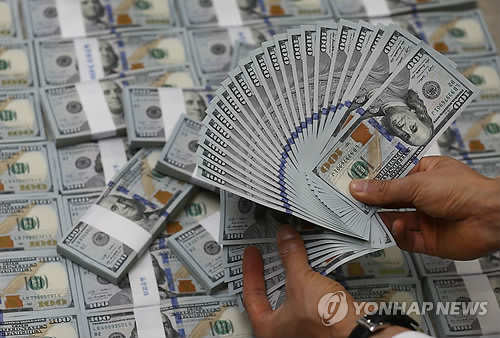
The net short-term foreign liabilities of major South Korean lenders have surpassed 40 trillion won ($34.09 billion), market sources noted Sunday, a potential threat to the banks' foreign currency soundness, especially following what many see as an imminent U.S. rate hike.
According to the sources, the combined foreign liabilities of the country's six major banks that will mature in less than two years stood at 37.11 trillion won as of last week.
The total owed by all local lenders currently stands well above 40 trillion won, considering the additional 2.9 trillion won owed by Nonghyup Bank alone, they said.
The six major banks are the Export-Import Bank of Korea (EXIM Bank), the Korea Development Bank, Kookmin Bank, Shinhan Bank, KEB Hana Bank and the Industrial Bank of Korea.
Of the total owed by the six major commercial banks, about 13.2 trillion won needs to be paid back before the end of this year, with the remaining 24 trillion won due before the end of 2017.
Market observers, as well as the banks themselves, insist they will have no serious problems in meeting their debt obligations.
However, many believe their ability to pay debt may be undermined should the U.S. Federal Reserve raise its key interest rate as widely anticipated, a move that may also lead to a rise in the sheer amount owed by the South Korean banks.
They say a U.S. rate hike will likely prompt an outflow of foreign capital from South Korea, making it harder and more expensive for the local lenders to secure the foreign currency they need to pay back their maturing debt.
"The possibility of capital outflows cannot but grow if U.S. interest rates go up while local interest rates continue to drop," a bank official said, speaking on condition of anonymity.
Despite its decision to hold the key rate steady in its June meeting, the U.S. Fed maintained it will raise the interest rate twice this year. South Korea's central bank, on the other hand, slashed its own key rate to a new record low of 1.25 percent this month.
Already, major global credit rating agencies, including Moody's and Standard & Poor's, have lowered the credit ratings of South Korean banks or are considering doing so, citing the banks' growing financing costs.
Moody's, for instance, has revised down the credit rating of Woori Bank by a notch to A2, while also lowering its long-term credit outlook for five other South Korean banks from stable to negative.
In a pre-emptive attempt to ensure long-term stability of South Korean banks, the local government recently announced a set of measures aimed at strengthening the liquidity positions of local lenders that include the introduction of a foreign exchange liquidity coverage ratio. (Yonhap)







